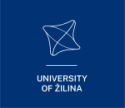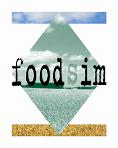
Conference Venue
 Dublin meaning Town of the Hurdled Ford, is the largest city in Ireland and the capital of the Republic of Ireland. It is located near the midpoint of Ireland's east coast, at the mouth of the River Liffey and at the centre of the Dublin Region. Founded as a Viking settlement, the city has been Ireland's primary city for most of the island's history since medieval times. Today, it is an economic, administrative and cultural centre for the island of Ireland, and has one of the fastest growing populations of any European capital city.
Dublin meaning Town of the Hurdled Ford, is the largest city in Ireland and the capital of the Republic of Ireland. It is located near the midpoint of Ireland's east coast, at the mouth of the River Liffey and at the centre of the Dublin Region. Founded as a Viking settlement, the city has been Ireland's primary city for most of the island's history since medieval times. Today, it is an economic, administrative and cultural centre for the island of Ireland, and has one of the fastest growing populations of any European capital city.
|
The writings of the Greek astronomer and cartographer Ptolemy provide perhaps the earliest reference to human habitat in the area now known as Dublin. In around A.D. 140 he referred to a settlement he called Eblana Civitas. The settlement 'Dubh Linn' dates perhaps as far back as the first century BC and later a monastery was built there, though the town was established in about 841 by the Norse. The subsequent Scandinavian settlement was on the River Poddle, a tributary of the Liffey, to the East of Christchurch, in the area known as Wood Quay. The Dubh Linn was a lake used by the Scandinavians to moor their ships and was connected to the Liffey by the Poddle. The Dubh Linn and Poddle were covered during the early 1800s, and as the city expanded they were largely forgotten about. The Dubh Linn was situated in the area of the park of the Chester-Beaty Library in Dublin Castle. |
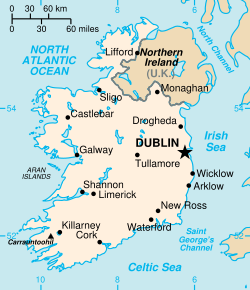
|
Since the beginning of Anglo-Norman rule in the 12th century, the city has served as the capital of the island of Ireland in the varying geopolitical entities:
* the Lordship of Ireland (1171–1541)
* the Kingdom of Ireland (1541–1800)
* the island as part of the United Kingdom of Great Britain and Ireland (1801–1922)
* the Irish Republic (1919–1922)
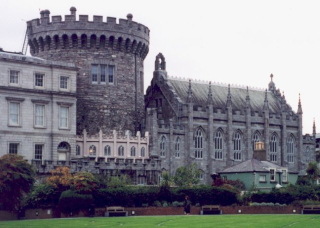
|
The modern city retains the Anglicised Irish name of the former and the original Irish name of the latter. After the Norman invasion of Ireland, Dublin became the key centre of military and judicial power, with much of the power centering on Dublin Castle until independence. From the 14th to late 16th centuries Dublin and the surrounding area, known as the Pale, formed the largest area of Ireland under government control. The Parliament was located in Drogheda for several centuries, but was switched permanently to Dublin after Henry VII conquered the County Kildare in 1504. |
Dublin also had local city administration via its Corporation from the Middle Ages. This represented the city's guild-based oligarchy until it was reformed in the 1840s on increasingly democratic lines.
From the 17th century the city expanded rapidly, helped by the Wide Streets Commission. Georgian Dublin was, for a short time, the second city of the British Empire after London. Much of Dublin's most notable architecture dates from this time. The Guinness brewery was also established at this time. The 1800s were a period of decline relative to the industrial growth of Belfast; by 1900 the population of Belfast was nearly twice as large. Whereas Belfast was prosperous and industrial, Dublin had become a city of squalor and class division, built on the remains of lost grandeur, as best described in the novel 'Strumpet City', by James Plunkett, and in the works of Sean O'Casey. Dublin was still the primary centre of administration and transport for much of Ireland, though completely bypassed by the Industrial revolution. The Easter Rising of 1916 occurred in the city centre, bringing much physical destruction. The Anglo-Irish War and Irish Civil War contributed even more destruction, leaving many of its finest buildings in ruins.
|
From 1922, following the partition of Ireland, it became the capital of the Irish Free State (1922–1949) and now is the capital of the Republic of Ireland. (Many of these states co-existed or competed within the same timeframe as rivals within either British or Irish constitutional theory.) One of the memorials to commemorate that time is the Garden of Remembrance. |
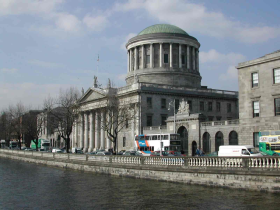
|
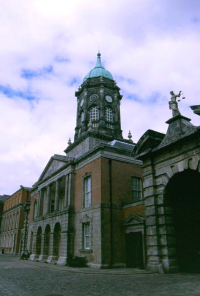
|
The Irish Free State rebuilt many of the buildings and moved parliament to Leinster House. Through The Emergency (World War II), until the 1960s, Dublin remained a capital out of time: the city centre in particular remained at an architectural standstill. Interestingly enough, this made the city perfect ideal for historical film production, with many productions including The Blue Max, and My Left Foot, capturing the cityscape at this time. This became the foundation of later successes in cinematography and film-making. |
|
With increasing prosperity, modern architecture was introduced to the city, though a vigorous campaign started in parallel to restore the Georgian greatness of Dublin's streets, rather than lose the grandeur forever. Since 1995, the landscape of Dublin has changed immensely, with enormous private and state development of housing, transport, and business. Some well-known Dublin street corners are still named for the pub or business which used to occupy the site before closure or redevelopment. |
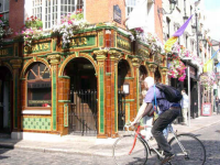
|
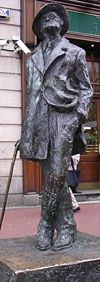
|
The city has a world-famous literary history, having produced many prominent literary figures. Indeed, as birthplace of William Butler Yeats, George Bernard Shaw and Samuel Beckett, Dublin has produced three winners of the Nobel Prize for Literature - more than any other city in the world. Other influential writers and playwrights from Dublin include Oscar Wilde, Jonathan Swift and the creator of Dracula, Bram Stoker. It is arguably most famous, however, as the location of the greatest works of James Joyce. Dubliners is a collection of short stories by Joyce about incidents and characters typical of residents of the city in the early part of the 20th century. His most celebrated work, Ulysses, is also set in Dublin and full of topographical detail. Additional widely celebrated writers from the city include J.M. Synge, Seán O'Casey, Brendan Behan, Maeve Binchy, and Roddy Doyle. Ireland's biggest libraries and literary museums are found in Dublin, including the National Print Museum of Ireland and National Library of Ireland. |
|
There are several theatres within the city centre, and various world-famous actors have emerged from the Dublin theatrical scene, including Noel Purcell, Brendan Gleeson, Stephen Rea, Colin Farrell and Gabriel Byrne. The best known theatres include the Gaiety, the Abbey, the Olympia and the Gate. The Gaiety specialises in musical and operatic productions, and is popular for opening its doors after the evening theatre production to host a variety of live music, dancing, and films. The Abbey was founded in 1904 by a group that included Yeats with the aim of promoting indigenous literary talent. It went on to provide a breakthrough for some of the city's most famous writers, such as Synge, Yeats himself and George Bernard Shaw. The Gate was founded in 1928 to promote European and American Avante Guarde works. The largest theatre is the Mahony Hall in The Helix at Dublin City University in Glasnevin. |
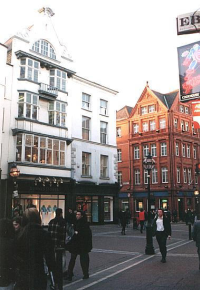
|
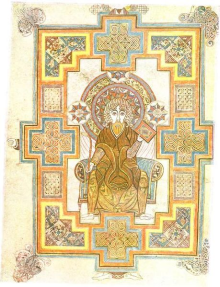
|
Dublin is also the focal point for much of Irish Art and the Irish artistic scene. The Book of Kells, a world-famous manuscript produced by Celtic Monks in A.D. 800 and an example of Insular art, is on display in Trinity College. The Chester Beatty Library houses the famous collection of manuscripts, miniature paintings, prints, drawings, rare books and decorative arts assembled by American mining millionaire (and honorary Irish citizen) Sir Alfred Chester Beatty (1875-1968). The collections date from 2700 B.C. onwards and are drawn from Asia, the Middle East, North Africa and Europe. Work by local artists is often put on public display around St. Stephen's Green, the main public park in the city centre. In addition large art galleries are found across the city, including the Irish Museum of Modern Art, the National Gallery, the Hugh Lane Municipal Gallery, The City Arts Centre, The Douglas Hyde Gallery, The Project Arts Centre and The Royal Hibernian Academy. |
Parts of this text were copied from 
 Conference Location
Conference Location
|
The FOODSIM'2008 conference will be held at The hotel is situated opposite the grounds of University College Dublin as shown on the map linked here. More information and maps can be found on the hotel page. |
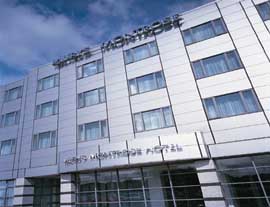
|
Getting to Dublin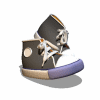
By Plane |
When arriving by regular airline, your airport of choice will be Dublin International Airport, which is located North of the city of Dublin. This website offers all sorts of information about the location of the airport and the buildings. It also shows where you can catch a bus, rent a car or take a taxi to Dublin city centre. Private Limousine hire is also available from The Irish Chauffeurs |
By Ferry |
When arriving by ferry there are several possibilities to reach Dublin City Centre and the conference site. Here you can find a map with the location of the terminal vis-a-vis the city centre. A list of ferry companies having their port of call in Dublin, can be found here. |
By Train |
Dublin is connected with the rest of Ireland by a number of direct intercity train connections. An overview of the intercity rail network is linked here. |
By DART and Tram |
If you travel up and down the coast North and South of Dublin, you can take the DART -"Dublin Area Rapid Transport" Railway. This link provides an overview of services and maps. An example map is linked here. Getting about in the city you can use the LUAS or Dublin Light Tram Network. An example map is linked here. |
By Bus |
In the city itself and outside there is also an extensive bus network at your disposal. This network also extends to the airport where you can take the following busses to the city centre. |
By Car |
As stated above, you can rent a car at the airport or at the Ferry station to travel to the conference site. You can find a map link here with the main roads in and around Dublin. |
By Taxi
|
When you wish to travel by taxi then you will find here a list of taxi companies in Dublin. |
Dublin Maps
|
Click on the map left for an expanded view. |
|
|
|
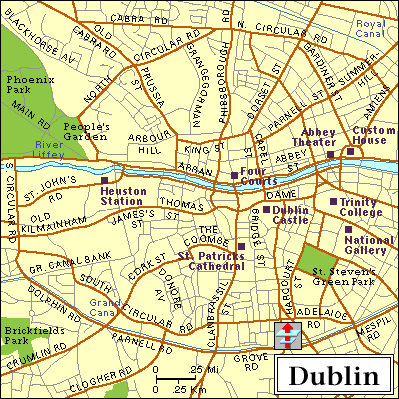
|


 Tel:+353(0)1 2693311
Tel:+353(0)1 2693311 Fax: +353(0)1 2693376
Fax: +353(0)1 2693376 Email:
Email: 







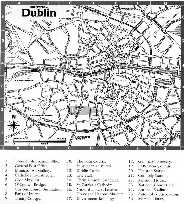

 Useful Links
Useful Links
